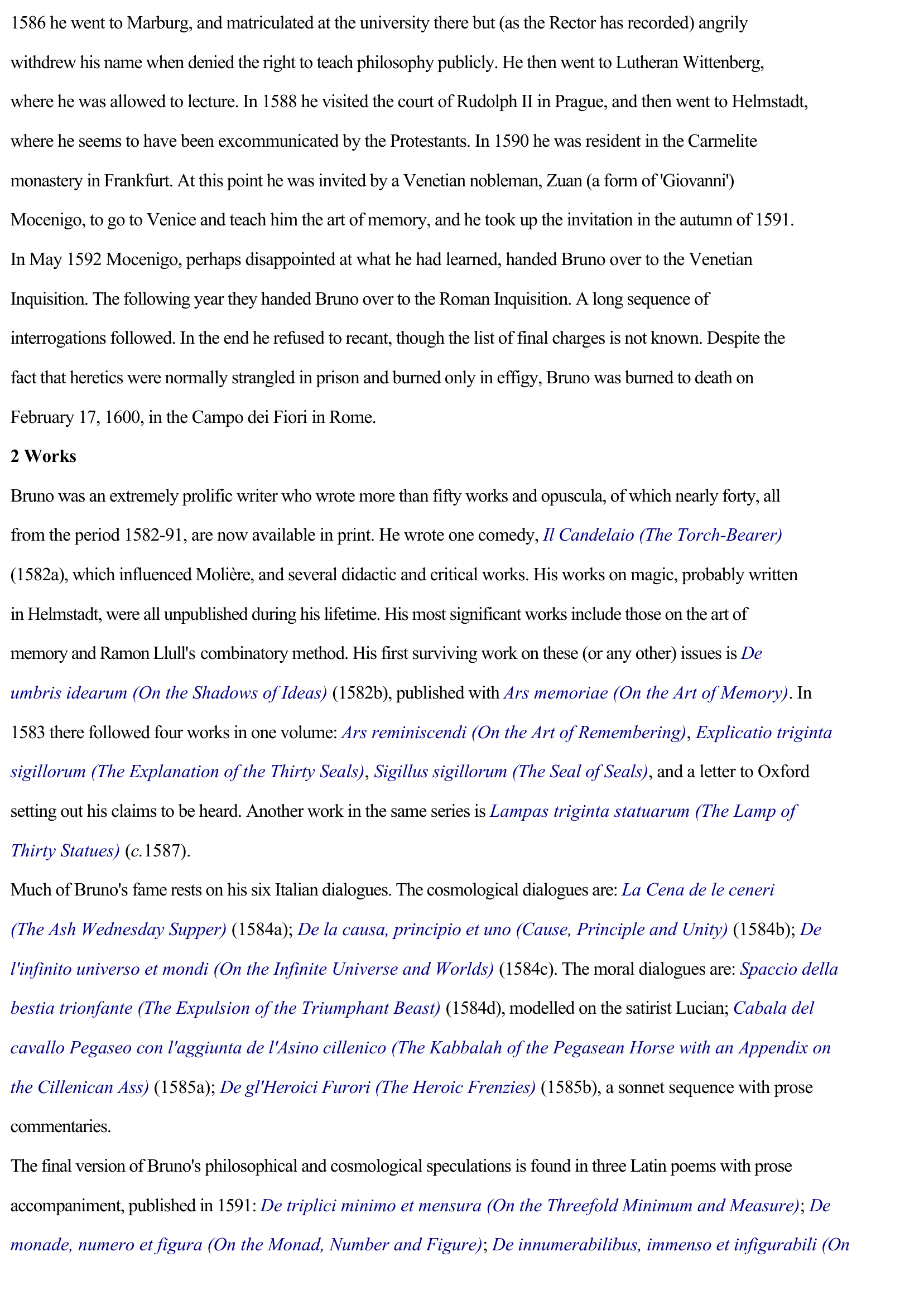Bruno, Giordano
Publié le 22/02/2012

Extrait du document
«
1586 he went to Marburg, and matriculated at the university there but (as the Rector has recorded) angrily
withdrew his name when denied the right to teach philosophy publicly.
He then went to Lutheran Wittenberg,
where he was allowed to lecture.
In 1588 he visited the court of Rudolph II in Prague, and then went to Helmstadt,
where he seems to have been excommunicated by the Protestants.
In 1590 he was resident in the Carmelite
monastery in Frankfurt.
At this point he was invited by a Venetian nobleman, Zuan (a form of 'Giovanni' )
Mocenigo, to go to Venice and teach him the art of memory, and he took up the invitation in the autumn of 1591.
In May 1592 Mocenigo, perhaps disappointed at what he had learned, handed Bruno over to the Venetian
Inquisition.
The following year they handed Bruno over to the Roman Inquisition.
A long sequence of
interrogations followed.
In the end he refused to recant, though the list of final charges is not known.
Despite the
fact that heretics were normally strangled in prison and burned only in effigy, Bruno was burned to death on
February 17, 1600, in the Campo dei Fiori in Rome.
2 Works
Bruno was an extremely prolific writer who wrote more than fifty works and opuscula, of which nearly forty, all
from the period 1582-91, are now available in print.
He wrote one comedy, Il Candelaio (The Torch-Bearer)
(1582a), which influenced Molière , and several didactic and critical works.
His works on magic, probably written
in Helmstadt, were all unpublished during his lifetime.
His most significant works include those on the art of
memory and Ramon Llull 's combinatory method.
His first surviving work on these (or any other) issues is De
umbris idearum (On the Shadows of Ideas) (1582b), published with Ars memoriae (On the Art of Memory) .
In
1583 there followed four works in one volume: Ars reminiscendi (On the Art of Remembering) , Explicatio triginta
sigillorum (The Explanation of the Thirty Seals) , Sigillus sigillorum (The Seal of Seals) , and a letter to Oxford
setting out his claims to be heard.
Another work in the same series is Lampas triginta statuarum (The Lamp of
Thirty Statues) (c.1587).
Much of Bruno's fame rests on his six Italian dialogues.
The cosmological dialogues are: La Cena de le ceneri
(The Ash Wednesday Supper) (1584a); De la causa, principio et uno (Cause, Principle and Unity) (1584b); De
l'infinito universo et mondi (On the Infinite Universe and Worlds) (1584c).
The moral dialogues are: Spaccio della
bestia trionfante (The Expulsion of the Triumphant Beast) (1584d), modelled on the satirist Lucian; Cabala del
cavallo Pegaseo con l'aggiunta de l'Asino cillenico (The Kabbalah of the Pegasean Horse with an Appendix on
the Cillenican Ass) (1585a); De gl'Heroici Furori (The Heroic Frenzies) (1585b), a sonnet sequence with prose
commentaries.
The final version of Bruno's philosophical and cosmological speculations is found in three Latin poems with prose
accompaniment, published in 1591: De triplici minimo et mensura (On the Threefold Minimum and Measure) ; De
monade, numero et figura (On the Monad, Number and Figure) ; De innumerabilibus, immenso et infigurabili (On.
»
↓↓↓ APERÇU DU DOCUMENT ↓↓↓
Liens utiles
- DÉBIT DE LA BÊTE TRIOMPHANTE (Le ) (résumé & analyse) de Giordano Bruno
- BANQUET DES CENDRES (Le) (résumé & analyse) de Giordano Bruno
- MONADE, DU NOMBRE ET DE LA FIGURE (De la) de Giordano Bruno - résumé, analyse
- BANQUET DES CENDRES (LE), Giordano Bruno (résumé)
- INFINI, L’UNIVERS ET LES MONDES (L’), Giordano Bruno - étude de l'œuvre

































